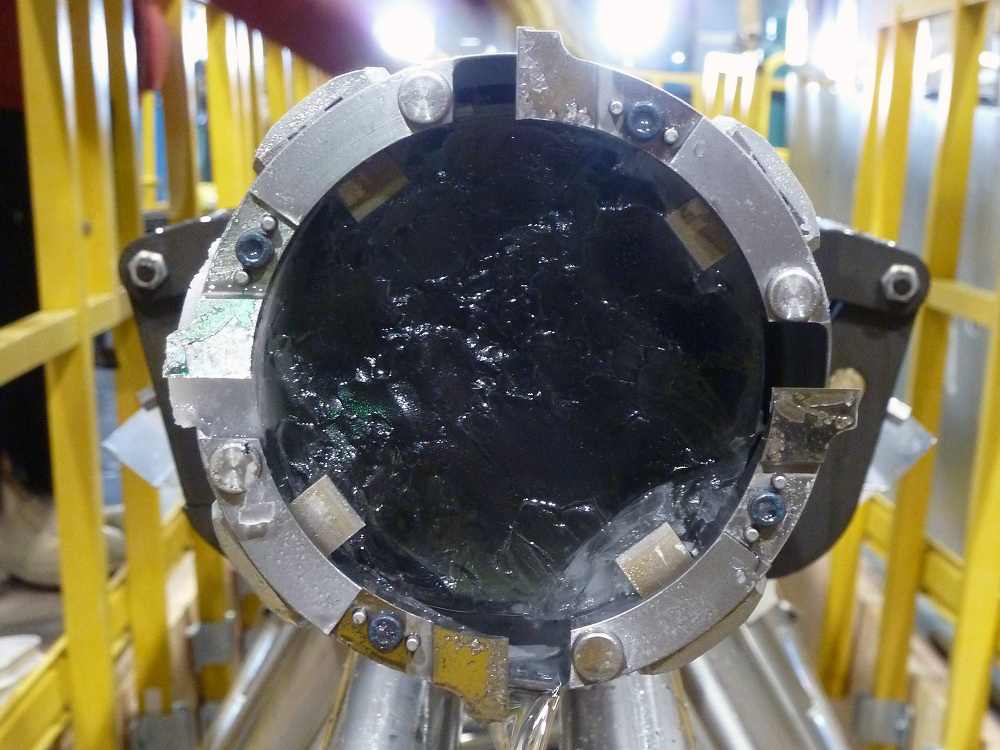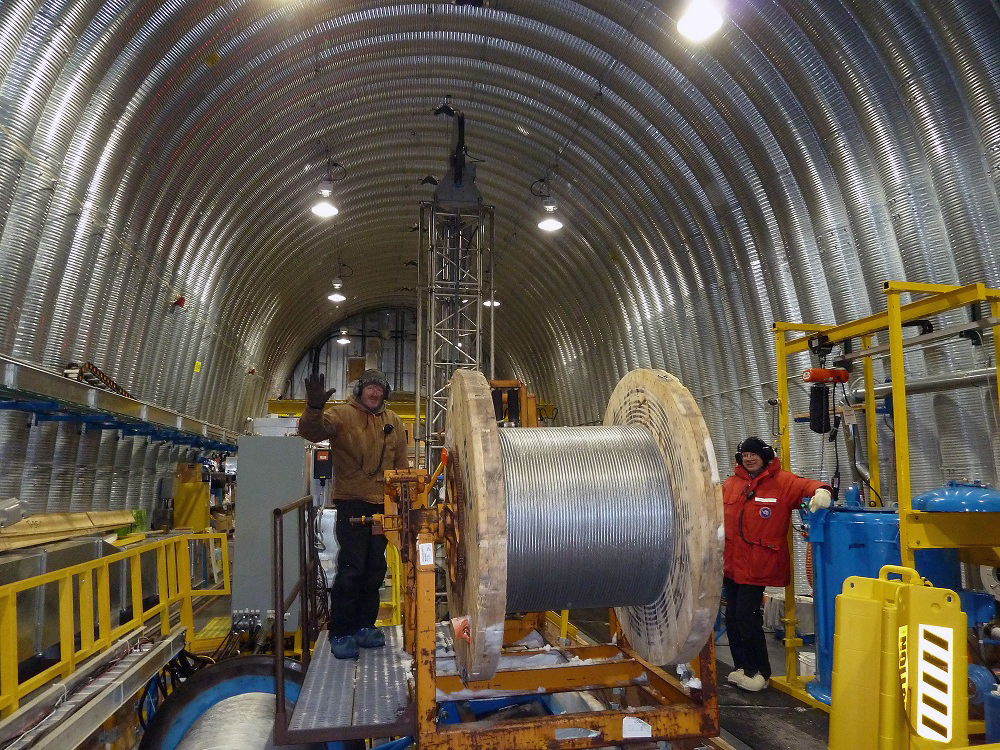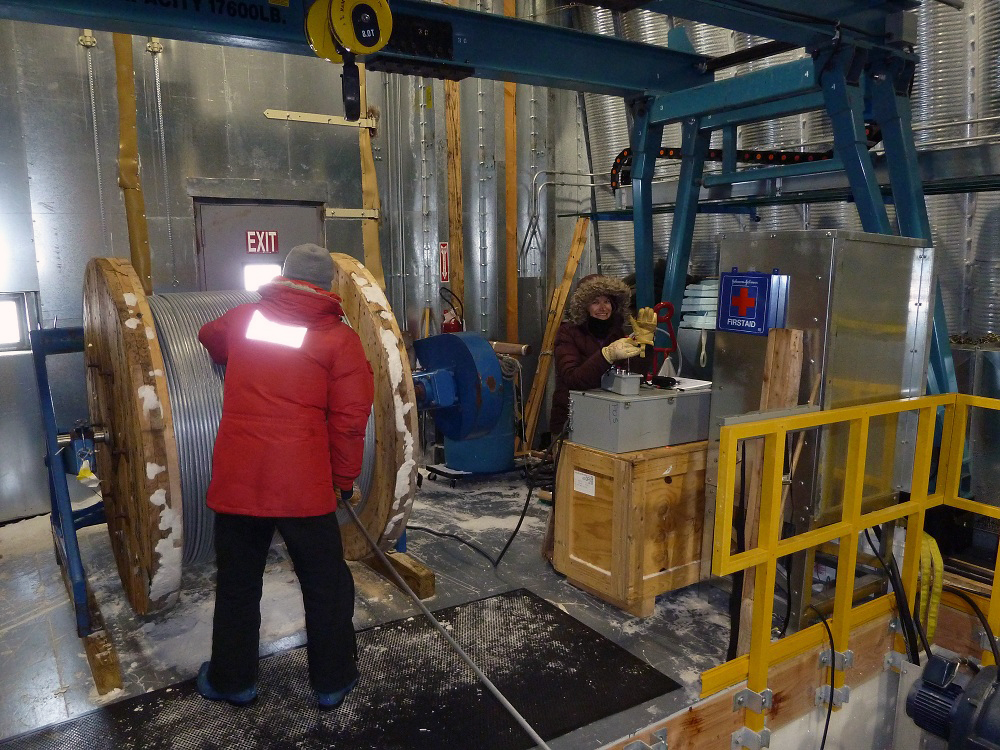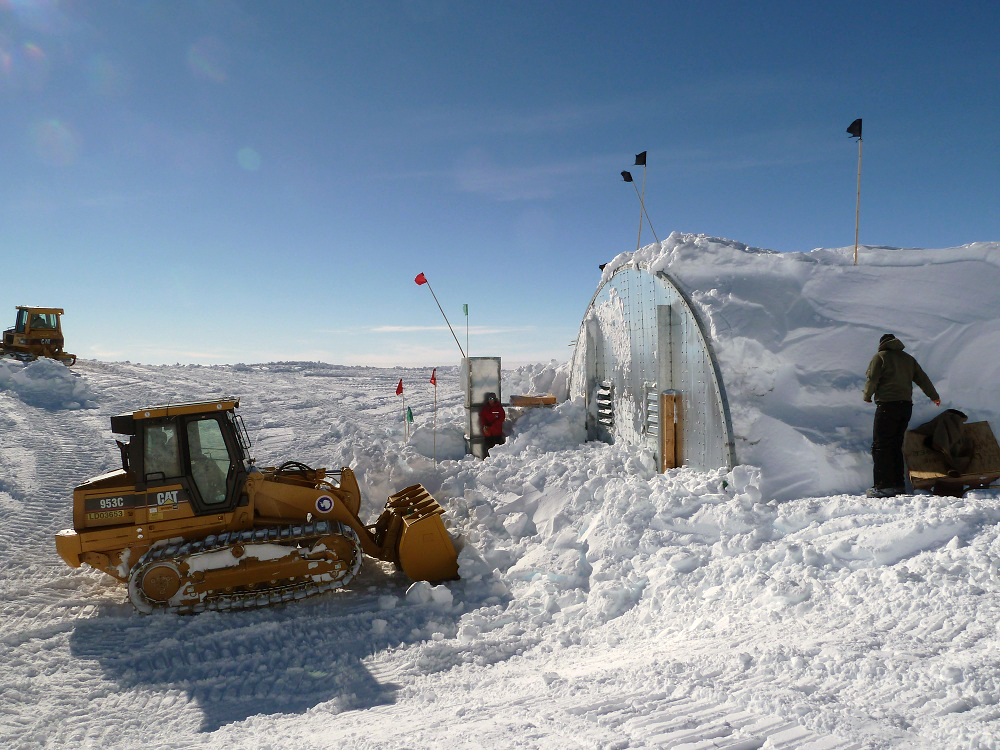News
End of Season Field Reports
2011-2012 Field Season
Ice Drilling Design and Operations (IDDO) Activities at WAIS Divide 2011-2012 (T-350)
NSF-OPP supported
PI: Charles Bentley (University of Wisconsin-Madison)
Field Team:
The IDDO field crew consisted of nine drillers lead by Jay Johnson, IDDO Drill Operations Engineer and Kristina Dahnert, IDDO Field Support Manager. The field crew and the dates of their stays at WAIS Divide are shown in the following table.
| Name | Date In | Date Out |
| Steffen Bo Hansen | January 10 | January 23 |
| Kristina Dahnert | November 22 | January 9 |
| Chris Gibson | January 3 | January 31 |
| Josh Goetz | November 22 | January 31 |
| Mike Jayred | November 22 | January 31 |
| Jay Johnson | January 3 | January 31 |
| Nicolai Mortensen | January 9 | January 31 |
| Elizabeth Morton | November 22 | January 31 |
| Paul Sendelbach | December 8 | January 9 |
| Chuck Zander | December 16 | January 31 |
Season Overview:
- Weather only delayed camp opening by six days. This is a decreased delay from previous seasons.
- Poor weather for entirety of season, with storms every 3-4 days bringing blowing snow and low visibility.
- Despite storms, temperatures were warm and WAIS Divide went above freezing, to 34°F, for 30 minutes one day.
- Thanks to excellent winter berm building the previous season, camp structures were quickly erected and heavy equipment fully operational in no time.
- Technically, no lost days due to weather
- Elizabeth, Jayred, Josh and Krissy arrived in camp prior to Arch excavation to assist with Arch assessment and tilting of the tower
- Don Voigt, the SCO Representative, also arrived with first drill crew to begin preparations for borehole logging
- Drill Arch sustained additional damage over winter
- Overall structure damage less than 2010 winter
- Severe heaving of floor near slot entrance
- From side wall of Arch to centerline was 11" of rise as measured in November 2010
- Side wall to centerline now measured a 19" rise in November 2011
- Additional rippling effect in floor down the length of the Arch
- Both crane rails were shimmed as planned
- Completed by RPSC Science Construction crew, supervised by Mike Jayred
- Rails/floor not made 'level' as leveling everything would create serious clearance issues with the cranes and other equipment in the building
- Difficulty leveling other equipment
- Core transfer trusses
- Removed and cut back window on bulkhead wall
- Removed all truss shims and 'started from scratch' this season
- Removed floor panel to use jig transit
- Optical table
- Core transfer trusses
- Cargo Movement
- DNF issue in McMurdo
- Drill computer rack found outside; outside between 1-13 days
- Function of winch and sonde computers tested prior to shipping to WAIS
- New procedures developed in McMurdo for DNF cargo
- Large Replicate crate mistakenly marked as DNF
- All cargo arrived at WAIS quickly
- New WAIS Divide Cargo Coordinator, Rafael Pizano
- The Pengo cable tensioner, P05 cable spooler and the old 3400m cable will remain at WAIS through the end of the project
- DNF issue in McMurdo
- Heavy Equipment Support
- Continued issues with the CAT 953 track loader and the CAT D4 dozer; one or the other was down for most of the season
- Have discussed the need for onsite spare parts with RPSC
- Pisten Bully critical to Arch snow removal
- PM schedule not completed during previous seasons; new lines ordered for hydraulic line failure, but necessary o-rings not procured
- Continued issues with the CAT 953 track loader and the CAT D4 dozer; one or the other was down for most of the season
- Generators
- The power system was reliable and had only a few unscheduled outages
- The fan hub on one of the 225kw generators failed violently on January 7th
- Several repair parts were required; this unit was down for the remainder of the season
IDDO Goals for the Season:
- Assist with borehole logging
- Install rooftop and slot-spanning sheaves
- Remove old 3400m cable from DISC Drill winch
- Spool on new 4200m cable
- Terminate fiber optics
- Deepen the main borehole to ~50m above the bed at the Chief Scientists direction
- Produce high quality ice core
- Adjust drilling procedures and techniques to drill and deliver warm ice, if encountered
- Test Replicate Coring capability
Borehole Logging:
- Elizabeth Morton served as a winch operator with Gary Clow and Frank Urban
- First round of logging completed between 12/3/11-12/21/11
- Second round of logging completed between 1/1/12-1/4/12
- Five logging tools deployed
- Optical dust logger
- Sonic 'snake' logger
- Seismic tool
- Temperature logger
- Sonic pinger
Early Season Activities:
- Cable Unspooling
- Unspooled 3400m cable off of the winch drum using the P05 cable spooler
- Cable Spooling
- Spooled on new 4200m cable using the Pengo cable tensioner
- Difficult to get enough pick height with the blue crane when lifting the cable spool due to the floor heaving in the middle of the Arch
- New cable was much cleaner than the old cable
- Cable Termination
- Terminated both ends of the fiber optic cable over a period of 5 days
- Very acceptable levels of dB loss, 13.5 - 15.0 dB, across all fibers
- Tested new cable spooling and terminating manual written prior to the season
- Manuals will now be released as controlled documents
- Took many photos to enhance documentation
- Took photos and wrote a short procedure for testing dB loss across the cable
- Terminated both ends of the fiber optic cable over a period of 5 days
Drilling:
- Starting depth: 3331.538m
- Ending depth: 3405.077m
- Total meters drilled: 73.539
- Total days at WAIS: 73
- 18 days for crew arrival, Arch work, slot work, logging set up
- 2 days for unspooling
- 2 days for spooling
- 5 days for cable termination
- 7 days for drill startup and other Arch prep o 2 days of borehole reaming/1 shift operation o 6 days of 2 shift operation
- Borehole deepened per original schedule
- No lost time!
- 20 days for replicate drill set up and testing o 2 days for packing
- Tripping speeds
- Descended at up to 1.0 m/s with the pump running
- Ascended at up to 2.0 m/s
- Cutter Speed
- 80rpm continues to be the sweet spot
- Penetration rates
- Varied with ice conditions
- Between 2.5-5.7 mm/s
- Borehole fluid
- Density was maintained at .920 @ -31°C throughout the season
- Fluid was mixed to .935 @ -31°C to compensate for 141B loss
- 4,391L (1,160 gal) of drilling fluid were used
- 3,140L (830 gal) of Isopar K
- 1,251L (330 gal) of 141b
- Total fluid loss for the season was 91%
- Loss for 2010-11 was 43%
- Loss for 2009-10 was 25%
- Loss for 2008-09 was 37%
- Loss for 2007-08 was 35%
- Note: The loss rate is higher than past seasons because of replicate drill testing. Also, the volume of the deviation created is not known and therefore was not accounted for in volume added to the borehole. It is therefore reflected as increased fluid loss.
- Weight on Bit
- Did not work for borehole deepening due to a wiring error
- WOB worked well after re-wiring
- Instrument section
- No problems (DISC section)
- Motor sections
- A few small intermittent leaks still persist in the compensator piston and where the housing sections meet
- Broken hall sensor wire in the compensator on section Z
- Repair was made without disassembling the motor section
- The pumps worked well
- The small winch motor would not stop when commanded to at times
- New problem this season
- The E-stop had to be used
- One of the 24v DC power supplies in the winch cabinet failed
- The power switch on the Glassman broke; repair made on site
- Spare Glassman in McMurdo shipped to WAIS
- WAIS Divide Main Borehole completed on December 31, 2011 at a final driller's depth of 3405.077 meters!
Replicate Coring Drill:
- Instrument sections
- Updated inclinometer with improved accuracy
- Initially had problems with the I2C power bus not coming up properly
- A timing delay was added in to solve the problem
- Fitted with a programming cable that permits changes to be made to the software without removing the instrument section it from the drill
- Assembly issue with loose cooling clamp on motor driver
- No instrument section failures
- Both sections were fluid tight
- Two deviating heads used
- Broaching head tried but did not achieve penetration into side wall
- Drill flexure is speculated to be the main reason
- Milling head used in a variety of configurations
- New face shoe for cutter head designed and machined onsite
- Broaching head tried but did not achieve penetration into side wall
- Actuator sections
- Wiring on strain gauges was easily damaged making them unusable
- Were found to not be needed and will most likely be removed for next season
- The failsafe mechanisms were found to trip at a lower force in the borehole than on the surface.
- The hall sensors were not reading reliably due to electrical noise from the interconnect cables
- Made the skew table unusable
- Rollers were made in the field for the lower actuator arms
- Two gear motors locked up and had to be replaced
- Cause of failure is not known at this time
- There were oil leaks on all actuator sections around the ball screw shafts
- Wiring on strain gauges was easily damaged making them unusable
- Screen and core barrels
- Centering pads on the screens had to be turned down so the screens would fit into the barrel
- The inner sleeve of the core barrel had a poor fit which required modifications in the field to resolve
- Replicate Drill Testing
- Verification that the sonde will find desired orientation
- Repeatable within ±15° after infield calibration of the six actuator channels
- Verified the sonde can find the uphill side of the borehole
- 25-30 screens full of chips were recovered
- Could not create a ledge
- The milling process was cutting ice, but not at the rate we were expecting it to
- Lack of stiffness in the drill seemed to prevent full intended side force from being applied to the cutter head
- Three major issues identified
- Axial stick-slip
- System rigidity
- Cutter geometry
- Verification that the sonde will find desired orientation
Lessons Learned:
- Overall System
- Stick slip of the drill made it difficult to achieve stable cutting
- Using the milling method, we were able to fill the screens
- The drill deflects more than originally anticipated
- The side push cutting method was not possible because the upper sonde is a smaller diameter than the barrels
- Complete system testing needs to be done at IDDO to better understand the dynamics of the system
- Control system/electronics
- Significant time was initially spent troubleshooting problems with the instrument section
- The system can reliably find the high side of the hole
- Auto azimuth works well
- The external programing cable on the instrument section was very useful
- Hall sensor count drift makes the lever position uncertain and the skew table unusable
- The system jumps out of auto operation on its own
- Actuators
- The fail safe mechanisms trip at a lower force in the hole than on the surface
- Oil leaks need to be addressed
- Two gear motors failed
- The strain gauges were never fully operational due to wiring and connector issues
- A more reliable method of monitoring arm position is needed
- Core and Screen barrels
- The threaded barrel connections work OK as long as the threads are kept very clean
- The screens didn't initially fit into the screen barrel
- Several modifications had to be made to the core barrels to make them usable
- More barrel length options would be useful
- Cutter heads
- The modular head arbor worked well
- We were unable to get the broaching head to cut. We suspect bending of the drill was the main reason.
- The milling cutters cut well radially, but the geometry could be better optimized
- Larger diameter cutters may be needed to compensate for drill deflection
- The cutters for the coring head had negative clearance on the OD and had to be modified to make them usable
- Surface operations
- The pivoting handles on the barrel wrenches made them unsafe to use
- Stiffer handles are needed on the barrel wrenches
- The barrel turning fixture should be modified to work with a 1m core barrel
- The screen table could use some refining to work better with different barrel combinations
Borehole Camera:
- New for 2011-2012 season
- New fiber optic transceivers had to be ordered and shipped directly to WAIS
- Centering blocks added to camera housing
- Two camera runs were done
Drill Cable Vacuum:
- A cable vacuum for removing drilling fluid from the winch cable as it comes out of the hole was installed
- Based on the one used by the Danes at NEEM
- Was effective at reducing the amount of drilling fluid carried up to the crown sheave and winch
Steffen Bo Hansen Visit:
- Steffen Bo Hansen, from the Centre for Ice and Climate (CIC) in Copenhagen, Denmark, visited WAIS Divide as a drill observer for two weeks in January
- His experience as a drill engineer provided good insight into issues experienced during Replicate Coring testing
- Was able to assist with trouble-shooting and driller training on the Badger-Eclipse Drill training
Safety:
- Safety Equipment & Inspections
- DISC Drill is well-equipped with PPE
- Equipment usage demonstrated with entire crew
- Startup, daily and weekly safety checks performed
- Safety Planning
- Camp managers and medics took a VERY active role in Arch safety Emergency planning
- Extensive planning and scenario-based meetings for first responder personnel in camp (both RPSC and science)
- Air Monitoring
- Ventilation system worked well again this season
- Approximately 1-2 air monitor alarms per drill run
- Alarmed mainly during ascent tripping
- O2 sensor still will not hold calibration
- Handheld oxygen monitor used for slot entry
- NICL monitor maintained by Don Voigt/SCO
- No reportable injuries the entire season
- A very safe season overall!
End of Season:
- Removed DNF items for McMurdo storage
- Winch cabinet returning to Madison via vessel for repairs
- Large 150hp winch motor also returning for repair
- Suspect bearings
- Outdoor equipment, including MECC, moved to winter berms
- Cargo returning to MSN:
- All sonde sections
- Replicate barrel sections
- Computer rack
- Electrical hardware and tools

Final core of the WAIS Divide deep borehole. Photo: Kristina Slawny.

Spooling on the new 4200-meter-long drill cable. Photo: Kristina Slawny

Unspooling of the old 3400-meter-long drill cable from the DISC Drill's winch drum. Photo: Kristina Slawny

Digging out the doors to the drilling and core handling arch at the beginning of the field season. Photo: Kristina Slawny

